
John Nash was one of the foremost British architects of the Georgian and Regency eras, during which he was responsible for the design, in the neoclassical and picturesque styles, of many important areas of London. His designs were financed by the Prince Regent and by the era's most successful property developer, James Burton. Nash also collaborated extensively with Burton's son, Decimus Burton.

Regent's Park is one of the Royal Parks of London. It occupies 410 acres (170 ha) of high ground in north-west Inner London, administratively split between the City of Westminster and the Borough of Camden. In addition to its large central parkland and ornamental lake, it contains various structures and organizations both public and private, generally on its periphery, including Regent's University and London Zoo.

Hyde Park Corner is between Knightsbridge, Belgravia and Mayfair in London, England. It primarily refers to its major road junction at the southeastern corner of Hyde Park, that was designed by Decimus Burton. Six streets converge at the junction: Park Lane, Piccadilly (northeast), Constitution Hill (southeast), Grosvenor Place (south), Grosvenor Crescent (southwest) and Knightsbridge (west). Hyde Park Corner tube station served by the Piccadilly line has many accessways around the junction as do its notable monuments. Immediately to the north of the junction is Apsley House, the 18th century townhouse of the 1st Duke of Wellington, hero of Waterloo. Several monuments to the Duke stand in the vicinity of the Corner, including Wellington Arch.

Decimus Burton was one of the foremost English architects and landscapers of the 19th century. He was the foremost Victorian architect in the Roman revival, Greek revival, Georgian neoclassical and Regency styles. He was a founding fellow and vice-president of the Royal Institute of British Architects, and from 1840 architect to the Royal Botanic Society, and an early member of the Athenaeum Club, London, whose clubhouse he designed and which the company of his father, James Burton, the pre-eminent Georgian London property developer, built.
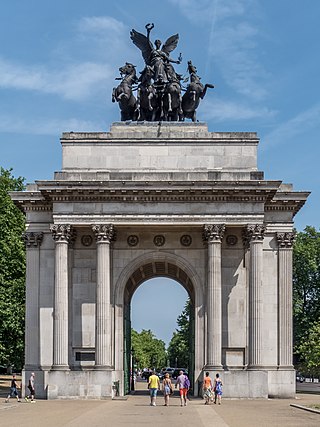
The Wellington Arch, also known as the Constitution Arch or (originally) as the Green Park Arch, is a Grade I-listed triumphal arch by Decimus Burton that forms a centrepiece of Hyde Park Corner in central London, between corners of Hyde Park and Green Park; it stands on a large traffic island with crossings for pedestrian access. From its construction (1826–1830) the arch stood in a different location nearby; it was moved to its current site in 1882–1883. It originally supported a colossal equestrian statue of the 1st Duke of Wellington by the sculptor Matthew Cotes Wyatt, acquiring its name as a result. Peace descending on the Quadriga of War by sculptor Adrian Jones, a bronze quadriga ridden by the Goddess of Victory Nike, has surmounted the arch since 1912.

Winfield House is an English townhouse in Regent's Park, central London and the official residence of the United States Ambassador to the United Kingdom. The grounds are 12 acres (4.9 ha), the second-largest private garden in London after that of Buckingham Palace.
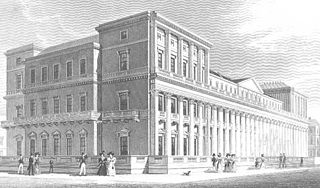
Carlton House Terrace is a street in the St James's district of the City of Westminster in London. Its principal architectural feature is a pair of terraces of white stucco-faced houses on the south side of the street overlooking St. James's Park. These terraces were built on Crown land between 1827 and 1832 to overall designs by John Nash, but with detailed input by other architects including Decimus Burton, who exclusively designed numbers 3 and 4.
The year 1827 in architecture involved some significant architectural events and new buildings.
The year 1818 in architecture involved some significant events.

Albany Street is a road in London running from Marylebone Road to Gloucester Gate following the east side of Regent's Park. It is about three-quarters of a mile in length.
Peter Frederick Robinson was an English architect.

Lieutenant-Colonel James Burton was the most successful property developer of Regency and of Georgian London, in which he built over 3000 properties in 250 acres. The Oxford Dictionary of National Biography contends that Burton was 'the most successful developer in late Georgian London, responsible for some of its most characteristic architecture'.
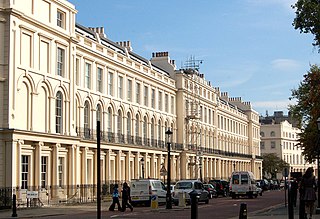
Park Square is a large garden square or private appendix to Regent's Park in London and is split from a further green, the long northern side of Park Crescent, by Marylebone Road and (single-entrance) Regent's Park tube station. It consists of two facing rows of large, very classically formed, stuccoed, terraced houses with decorative lower floor balconies and a colonnade of consecutive porticos by architect John Nash, and was built in 1823–24. Alike, shorter-length terraces flank its corners at right angles, equally Grade I listed buildings: Ulster Terrace, Ulster Place, St Andrew's Place and Albany Terrace.
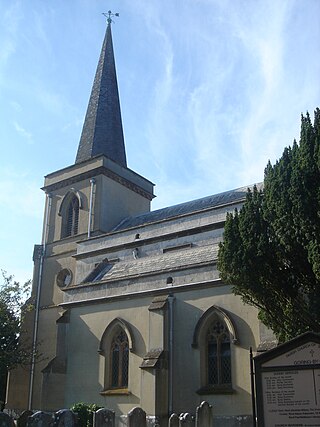
St Mary's Church is an Anglican church in the Goring-by-Sea area of the Borough of Worthing, one of seven local government districts in the English county of West Sussex. The late Norman parish church of the ancient village of Goring retains some architectural elements from that period, but Decimus Burton's comprehensive restoration of 1837 has given the church its present Gothic Revival exterior appearance. German artist Hans Feibusch, who worked extensively in the Diocese of Chichester, provided a mural in 1954: it is considered impressive, but caused controversy at the time. English Heritage has listed the church at Grade II* for its architectural and historical importance.

The London Colosseum was a building to the east of Regent's Park, London. It was built in 1827 to exhibit Thomas Hornor's "Panoramic view of London", the largest painting ever created.
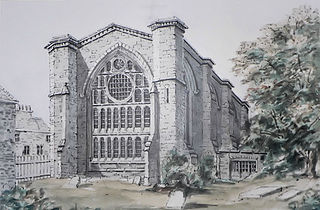
The Royal Foundation of St Katherine is a religious charity based in the East End of London. The Foundation traces its origins back to the medieval church and monastic hospital St Katharine's by the Tower, established in 1147, next to the Tower of London.

Cornwall Terrace is a Grade I listed building of consecutive terraced mansions overlooking Regent's Park in the City of Westminster, London. It is situated at the park's southwest corner, near Baker Street, between York Terrace and Clarence Terrace, within the park's Crown Estate development. Cornwall Terrace was part of the scheme of the Prince Regent, later King George IV, to develop grand housing in Regent's Park. The buildings are Grade I listed buildings.

Grimston Park is a grade II* listed Georgian country house in Grimston, North Yorkshire, England, some 1.7 miles (3 km) south of Tadcaster. Since being owned by the Isherwood family, it has been converted into a number of luxury homes.

Holford House was an English country house built in the Regent's Park in 1832, then on the outskirts of London. It was used at various times in its history as a private residence and an educational college for Dissenters before being destroyed by a German air raid in 1944.
Francis Robert Glindon was a British singer, songwriter, and scene painter.
















